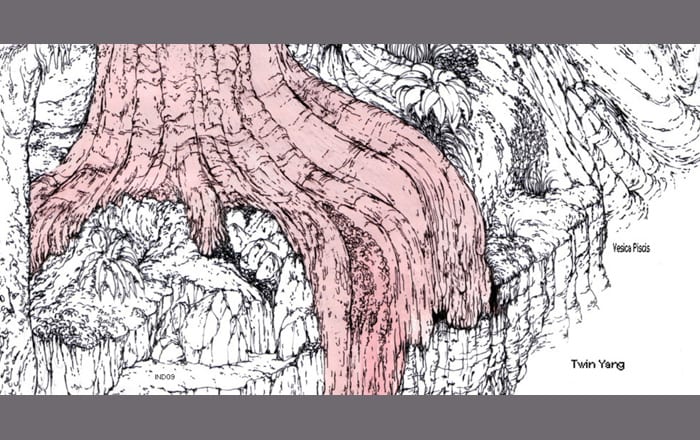
Local multi-instrumentalist and composer Jason Gottfried has been working long-distance in collaboration with Sean McDonald, an ambient musician, multi-instrumentalist, producer, and owner of tape label Mmm Sound who lives in Ashville, North Carolina. Over the course of the past year, the duo has released two albums that defy categorization, the most recent of which, “Twin Yang,” was published by London label Indole Records.
Vesica Piscis combines Gottfried’s melodic and harmonic sensibilities with McDonald’s penchant for experimental sound design, resulting in something that is difficult to describe. Of Vesica Piscis’ first album, “Optical Mystic!,” the ambient and experimental music blog Microphones In The Trees said it sounds “like a smoldering Atari cartridge played through an 8-track deck in the overgrown ruins of a Volkswagon on a commune in Eugene, Oregon.”
As Gottfried is a local artist who’s doing something different in southern Utah (and a prolific album reviewer unafraid to tackle anything from Blues Traveler to Brian Wilson, and Modest Mouse to Faith No More), The Independent decided to interview him and McDonald about their latest release, “Twin Yang.”
Indy: First of all, how do you two know each other? It seems kind of random and impractical, geographically.
Jason: Well, I moved to Cedar City from Gainesville, Florida at the end of 2013. I’d lived there for close to four years and was playing and recording a lot. And Sean ran in the same circles as I did, with the people associated with the Elestial Sound and Housecraft labels, the Church of Holy Colors, the MILAGROS art consortium, and so on. There is a ton of art and music going on in Gainesville. I lived in Nashville for a while, and it was cool, but I preferred the scene in Gainesville by far. Musicians there are sooo way outside the box. In Nashville, they’re all writing jingles or busy trying to get famous or whatever. So anyway, I’d seen Sean play solo several times, and it was pretty mind-blowing, some of the craziest music I’ve ever heard. I thought his stuff with Jeff Astin as Mannateas was incredible. We just kept in touch when I moved.
Sean: Yeah. Pretty much.
I: So tell us a little about the technical details of what you each do from your end to make this stuff.
J: Besides using an acoustic guitar, an electric guitar, and a bass, I’m using two really old, cheap keyboards—a Yamaha PSR-6 and a Casio CT-607—and I’m running them through delay, two equalizers, a compressor, and a wah pedal, mostly because that’s about all I have. It’s all going straight into a Boss RC-50 loop pedal. There’s no quantizing or MIDI or anything, no software involved at all, just instruments and hardware. This pedal can juggle three loops at once, so sometimes I make three loops that can be layered on top of each other. Other times, I make a rhythmic loop, then a loop in one key and another loop that modulates from the second one, and I alternate them. I tended to do more layering in the second album.
S: With both Vesica Piscis releases, my body is seen as such: a tall man hovering over a desk covered with looping pedals, samplers and a laptop. At specific points, my back hurts. Overall, I loop, get it right, don’t, re-record. At times, I am dancing. With this album, I jumped up onto my futon without regard and danced. I shimmy. A lil’ gimme gimme. You know the routine.
I: What’s your general aesthetic approach? You know, influences and so on. Obviously not country or hip-hop.
J: To some degree, I’m pretty much always hybridizing elements from Japanese video game composers from 20 years ago—guys like Yasunori Mitsuda or Nobuo Uematsu—and elements from jazz guitarists like Pat Metheny or any of the post-romanticists like Stravinsky or Barber. I could go on. And minimalists like Steve Reich, Philip Glass, Terry Riley, all those dudes. I mean, really, you could argue that most electronic sample-based music—you know, like more along the lines of Boards of Canada, not that clubby EDM crap—is probably the most relevant contemporary extension of classical minimalism. Of course, the limited equipment that I have dictates heavily what sounds I have to work with, so everything sounds pretty “retro.”
S: I’m always interested in breaking the barriers of structured sound consciousness. The modern era hears a building block that I can deconstruct. Not out of anything that could be an antagonist. Only to redefine elements unheard ultimately, and unintentionally, specifying to a minority of those who can hear … at all.
I: I guess this album isn’t “about” anything. Is it? Any commentary about mood or imagery you were trying to evoke?
S: Open, with reserves one is willing to tap into. Questioning ourselves … bigger questions. Not only, “What did I eat today, who do I love, when do I work.”
J: Each time I sat down to compose, I just did whatever came to mind. After the initial melody or chord progression or whatever was laid down, everything else was just development and texture. And then I’d give it a silly title, like “Duck Biscuits.” Or, you know, one day, I was working on it, and I’d given blood and was feeling super wacky, so that one is “Blood Loss.” But it’s definitely absolute music, there’s no subtext. Although the way Sean has arranged things, there’s definitely a narrative present, which is probably what I like most about it. Like going for a really weird walk.
I: How did “Twin Yang” get picked up by Indole?
J: That’s Sean’s department.
S: I heard a Venn Rain tape while laying on a hardwood floor years ago. It was called “Place in World.” It’s a beautiful tape, and it changed my view. I contacted Jimmy from Venn Rain, Holovr, and Indole years later, and we became online buds.
I: So how does “Twin “Yang” differ from “Optical Mystic”?
J: Well, with “Optical Mystic,” I sent a big pile of loop material to three multi-instrumental producer/composer-types in Gainesville and said “Hey, play around with these if you want.” And Sean put together “Optical Mystic” in only a couple weeks, maybe less. It was really fast. When I heard it, I was amazed. There is no way I would have ever done anything like what he did with the material. Things don’t line up correctly, or what is in my mind “correctly.” Sean really mangled the hell out of my pre-imagined conceptualization of how things “should” sound. And I listen to a lot of ambient and experimental music, so I feel that my ears are “loosened” up enough to appreciate it.
And really, it’s totally sublime. I still have both albums on my iPod. Then again, I feel that he has a more … I don’t know … “bizarro” aesthetic than I do. I mean, when I use these loops live, I set them up, layer them in properly, and improvise over them as something else I do that I call “Electric Kirtan.” Someone once told me that he thought I was a Pat Metheny CD when I was doing that…if that tells you anything about how it sounds. But Sean cut them up and made an incoherent ransom letter. “Twin Yang” is just made out of different magazine clippings.
S: Seeing can be done with other either of the eyes open. I do not recommend it for beginners.
Gottfried is a freelance musician, playing and recording in Utah and the surrounding area and teaching lessons. He can be reached at cedarsanctuarystudio.wordpress.com.
McDonald, who is composing and recording prolifically while continuing to run Mmm Sound, can be reached at http://www.mmm-sound.com.
“Twin Yang” by Vesica Piscis can be heard in its entirety and purchased in either CD or digital format at https://indolerecords.bandcamp.com/album/twin-yang.
To see Jason’s album reviews for The Independent, just type “Jason Gottfried” into the search field above. Then prepare to be entertained.




